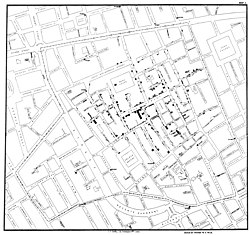1854 Broad Street cholera outbreak
The Broad Street cholera outbreak (or Golden Square outbreak) was an outbreak of cholera that happened in 1854 near Broad Street (now Broadwick Street) in Soho, London, England. The even happened during the worldwide 1846–1860 cholera pandemic. The outbreak caused the deaths of 616 people. It is best known for the physician John Snow's study of what caused it. He said that germ-contaminated water was the source of cholera. The common belief was that it was caused by particles in the air. This was referred to as "miasma".[1][2] His discovery led to changes in public health. It also caused changes to the construction of sanitation facilities in the mid-19th century.
| Part of 1846–1860 cholera pandemic | |
 A replica pump commemorating the outbreak and John Snow's investigation of it. | |
| Date | 1854 |
|---|---|
| Coordinates | 51°30′48″N 0°08′12″W / 51.51334°N 0.13667°WCoordinates: 51°30′48″N 0°08′12″W / 51.51334°N 0.13667°W |
| Cause | Cholera present within the pumping water. |
1854 Broad Street Cholera Outbreak Media
Original map by John Snow showing the clusters of cholera cases (indicated by stacked rectangles) in the London epidemic of 1854. The contaminated pump is located at the crossroads of Broad Street and Cambridge Street (now Lexington Street), running into Little Windmill Street.
The pub, close by to the new location of the pump, named after John Snow
A wider image of the pub named after John Snow with the pump centre-right
References
- ↑ Eyeler, William (July 2001). "The changing assessments of John Snow's and William Farr's Cholera Studies". Sozial- und Präventivmedizin. 46 (4): 225–32. doi:10.1007/BF01593177. PMID 11582849. S2CID 9549345.
- ↑ Paneth, N; Vinten-Johansen, P; Brody, H; Rip, M (1998-10-01). "A rivalry of foulness: official and unofficial investigations of the London cholera epidemic of 1854". American Journal of Public Health. 88 (10): 1545–1553. doi:10.2105/ajph.88.10.1545. ISSN 0090-0036. PMC 1508470. PMID 9772861.






